|
|
|

Topics in this section: work and trade | leisure activities | hunting and fishing | food and drink | health and wellbeing | dress
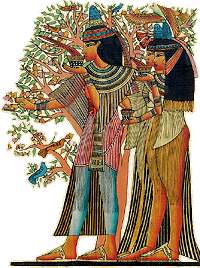 The hot and sunny climate of Ancient Egypt meant that simple lightweight linen clothes were the preferred choice of most Egyptians. Whilst a number of examples of New Kingdom textiles have survived, studies of Ancient Egyptian dress and textiles are still largely based upon the study of wall paintings, reliefs and sculptures. The hot and sunny climate of Ancient Egypt meant that simple lightweight linen clothes were the preferred choice of most Egyptians. Whilst a number of examples of New Kingdom textiles have survived, studies of Ancient Egyptian dress and textiles are still largely based upon the study of wall paintings, reliefs and sculptures.
The well documented kohl-rimmed eyes of the ancient Egyptians are one of their most distinctive features. Cosmetics were not considered a luxury, and most people, from the simple peasant upwards to pharaoh himself used them. The only real difference between the classes was the quality of the products used. Men and women followed the latest fashions in both hairstyles, make-up and fashion.
The ancient Egyptians loved ornamentation, and all forms of jewellery, including necklaces, rings, anklets and bracelets were popular fashion accessories. Designed, crafted and worn with great thought and care, jewellery was valued not only for its beauty and precious metals, but also for the magical and spiritual protection it was thought to give the wearer. Even the poor wore jewellery, but unlike the richer nobles or royalty, their pieces tended to be mainly decorative and non precious, and usually a simple good-luck symbol or protective amulet.
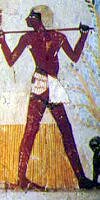 |
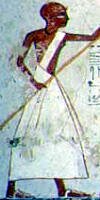 |
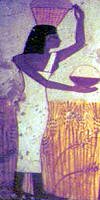 |
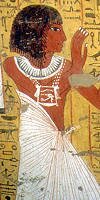 |
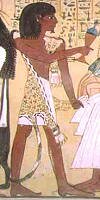 |
| Different styles of loincloth, kilt and dress worn by the ancient Egyptians |
Men usually dressed in short linen kilts sometimes with a band of cloth worn over the shoulders, and women in long fitted linen dresses. During the New Kingdom, fashion became more complex, with intricate pleats introduced to tunics and dresses. Ordinary Egyptians wore course linen, whilst the richer and wealthier Egyptians dressed in a lighter, much finer cloth. Semi-transparent "royal linen" was the finest of all. Skins, usually leopardskin would sometimes be worn by priests (see above) and the pharaoh for important temple and religious rituals. Elaborate clothing and head-dresses were worn by royalty for ceremonial occasions.
Producing the cloth ...
Textile manufacture and dressmaking were the only areas of the economy that remained predominantly in female hands. For a long time it was mainly the women who were working in the spinning and weaving workshops. Many of these workshops were incorporated within the more wealthy and aristocratic houses of the nobility.
| Linen was produced from the flax plant. By stripping, beating and combing the flax, long flat strips of fibre were produced. These strips could then be spun into threads and were then twisted into balls and stored as such until required. The threads would then be woven into fabric. |
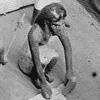 |
 |
 |
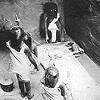 |
The weaving was done at first on horizontal looms, which were often just pegs rammed into the ground, where the workers had to crouch on the floor, and later during the New Kingdom on vertical looms. Dressmaking tools included knives (made first from stone, then later copper, bronze and iron) and needles (wood, bone and metal).
|
Simple and practical ...
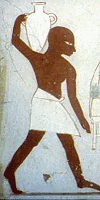 |
 |
The basic garments of the average Egyptian changed little throughout Egypt's history. The length of a man's kilt varied slightly, being initially short during the Old Kingdom, although within the upper classes it became fashionable to wear it longer. The kilt gradually lengthened during the Middle Kingdom, when it was often supplemented with a strip of linen draped loosely over the shoulder which evolved into short sleeves, and later into long sleeves.
The cloth, which was sometimes pleated, was wrapped round the waist and held in place by a belt. Very little stitching was used.
|
|
A woman's tunic was made from a long rectangular piece of cloth with an opening cut in the centre to fit over the head. The fabric was folded in half, and the lower sides were sewn together, leaving openings for the arms. The tunic could cover one or both shoulders, or be worn with shoulder straps. The top of the tunic could reach anywhere from the neck to below the breast, and was usually ankle length. The fit might be very tight or quite loose. A tied belt held the cloth together.
Diaphanous cloaks with short, wide sleeves made of special fine linen imported from Syria, became fashionable in the New Kingdom.
|
 |
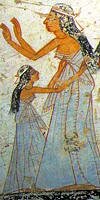 |
 |
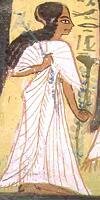 |
Egyptian art shows children as naked until puberty. Children are shown with their distinctive "sidelock" representing their youth, and as much smaller in scale than adults. During the Middle Kingdom some children are shown wearing linen clothes similar to adults, particularly in the cooler months. In some tomb paintings, both girls and boys are shown in linen tunics. Children wore jewellery, earrings, collars, bracelets, armlets and anklets and girls also wore hair ornaments. During the New Kingdom children's sidelocks were shown in a range of different styles.
Servants as a rule, went about their work either naked, or clad in little else other than a simple apron, skirt or small loincloth.
|
Discover the hairdos and wigs of the Ancient Egyptians >>
|
|
|






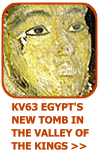
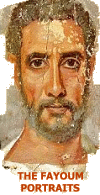
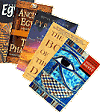
 The hot and sunny climate of Ancient Egypt meant that simple lightweight linen clothes were the preferred choice of most Egyptians. Whilst a number of examples of New Kingdom textiles have survived, studies of Ancient Egyptian dress and textiles are still largely based upon the study of wall paintings, reliefs and sculptures.
The hot and sunny climate of Ancient Egypt meant that simple lightweight linen clothes were the preferred choice of most Egyptians. Whilst a number of examples of New Kingdom textiles have survived, studies of Ancient Egyptian dress and textiles are still largely based upon the study of wall paintings, reliefs and sculptures.













